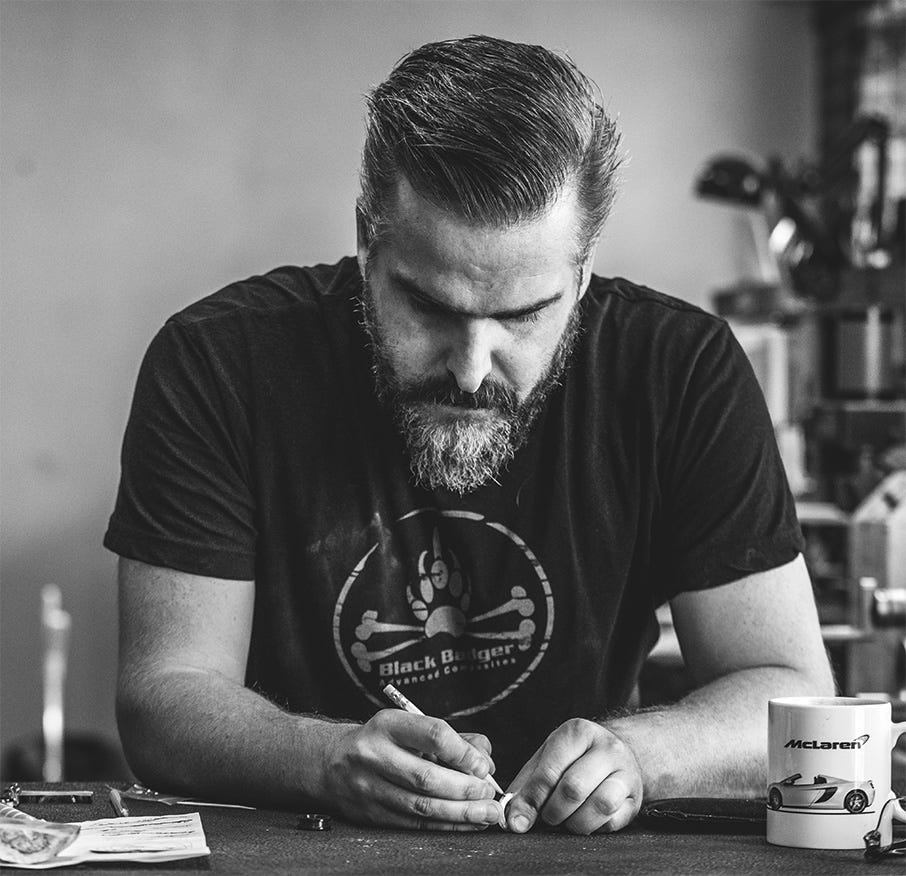The Fourth Wheel, Issue 115
Don't call him Black Badger. Or 'the lume guy'. In conversation with the multi-talented James Thompson.
Hello and welcome back to The Fourth Wheel, the weekly watch newsletter that’s belatedly realising the benefits of taking a summer break! Don’t get me wrong, I love doing this and I’ve got a great interview for you today with James Thompson, but, well, this week has been a week. On which note, a few of you have asked about the Vintage Bulletin and the podcast; the Bulletin is, I am sorry to say, still not ready to launch. I don’t want to give you something that isn’t up to scratch, and it’s just taking a long time to get the first one together. My firm expectation is that it will start in the autumn, and I can only apologise for not having it ready earlier. The podcast is in much healthier shape - episodes have been recorded and we (my co-host Tim Barber and I) are powering ahead. I’m wary of giving you a firm launch date just yet - as the VB situation demonstrates! - but it is happening in the not too distant future.
The Fourth Wheel is a reader-supported publication with no advertising, sponsorship or commercial partnerships to influence its content. It is made possible by the generous support of its readers: if you think watch journalism could do with a voice that exists outside of the usual media dynamic, please consider taking out a paid subscription. You can start with a free trial!
Here’s a little taste of what you might have missed recently:
Unsung Heroes: The Best Watches You’ve Forgotten Exist
Five Things Hodinkee Should Do Now
CEO changes and GPHG embargo-breaking
Ask Me Anything: Vol. 11
World Exclusive: Horological Dicktionary On The Record
Can I get a pedantic point off my chest? We are coming to the end of the Olympic Games and this little bugbear has built up to the point where I can’t ignore it.
Omega does not time the Olympic Games.
A company called Swiss Timing times the Olympic Games; Omega brands Swiss Timing’s efforts. Please don’t think this is pique or spite or envy talking; I think, in the grand cosmic scheme of things, I have more time for Omega than a lot of my peers. I just come from a place of preferring to see things honestly and accurately described. Omega may be the timekeeping partner of the Games, but in that regard it is analogous to Rolex’s role in Formula 1: branding, and lots of it. You could go through the Omega manufacture with a comb and not find a single piece of modern-day electronic sports timing equipment being produced.
Where the ambiguity comes in is that Omega used to time the Olympic Games. Swiss Timing as an entity was spun out of Omega’s - and Longines’ - in-house sports timing divisions back when such things were still mechanical and analogue. Encouraged by the FH, Omega and Longines signed the founding agreement for Swiss Timing in 1972, although the two did not completely amalgamate until 1988. In 1972, Omega and Longines were owned by SSIH and ASUAG respectively, the two holding companies that would eventually merge and become SMH, the forerunner of the Swatch Group, but at the time, they were separately owned.
Today, Swiss Timing is a separate subsidiary of the Swatch Group that provides world-class, highly innovative technology to sporting tournaments all over the world. It has its own CEO - a man called Alain Zobrist - and it works with many of the Swatch Group brands as a kind of white-label supplier. This isn’t any kind of secret; it’s all over Swiss Timing’s website. There are plenty of features written by journalists like myself from Swiss Timing’s HQ - I’ve done it, every four years people do it - and it is well known and understood in the industry, but then you get Mickey-Mouse stuff like the Wall St Journal actually referring to Zobrist as Omega’s CEO and my blood pressure starts to rise. Not because I think Omega is perpetrating some kind of duplicity or anything like that; as I said, this is really pedantic and I am sure I will have lost some of you a long time ago, but either you’re a stickler for specifics or you aren’t, and this is one of mine. There’s an irony here, too, because this rant concludes with me paying Omega - or really, Swatch Group - a huge compliment, because in the course of pulling at this particular thread I came to realise that through its ownership of Swiss Timing, Swatch Group might just be the only company whose primary business is making mechanical watches1 that is actually involved in any way whatsoever with cutting-edge timekeeping. What Swiss Timing does is genuinely brilliant, and I don’t think anyone else in the luxury watch industry is even remotely connected to such things2, and the fact that all its efforts - brought to bear as they are under the umbrella of a now-completely separate brand - are serving the end goal of trying to sell people a £50,000 Aqua Terra is simultaneously hilarious, depressing and completely typical of the luxury world.
While we’re here, using Daniel Craig to stealth-launch a watch was clever, effective and obviously a trick you can only pull off once to maximum impact. Craig has been lurking around Paris with his Leica and an as-yet-unreleased Seamaster, which looks very cool, as it happens. But Omega has lurched from quite a cool idea - planting a watch on Craig’s wrist and saying nothing about it for a few weeks - to just gracelessly giving him the watch and immediately telling the watch media that if they looked at Craig - who is looking more and more like he’s reprising his Mikael Blomqvist role - they’d see something interesting, nudge nudge wink wink. Play it cool guys!
Interview: James Thompson
James Thompson will be known to most of you as the founder of Black Badger, the Swedish materials atelier specialising in avant-garde, sci-fi-worthy rings, and as a perennial collaborator within the world of watches. He has worked with the likes of MB&F, Sarpaneva, Schofield, Linde Werdelin, Hautlence and Bamford Watch Department, usually but not exclusively creating watches that did something unusual with lume. In 2020 he became a co-owner of Arcanaut watches, the Danish indie watch brand. We caught up to talk about his glowing resumé, the hypocrisy of success, cringe-worthy collaborations, burnout, paintballing and The Simpsons.
TFW: We first met around about 2014, I think at SalonQP in London, and you were just getting started in your collaborations that specialised in creative uses of lume. Where did that all come from?
James Thompson: I'm probably on about the fifth generation of different lume materials that I've worked with, by now, but in the very beginning it was this stuff called Moonglow. That was an acrylic which came in 3mm thick sheets, and a lot of custom knife-makers would use little inserts for the handle of the knife or whatever, just to make it look cool. I had a knife-maker friend in the United States who said ‘You gotta try this stuff - it would go so well with all your crazy ideas’, because I was the carbon fibre guy at that point.
I still have the email saved somewhere where I was like, ‘Thanks for the tip, but you know, it sure looks stupid. I'm a serious designer, I'm not gonna screw around with some kind of Tron, Mickey Mouse kind of crap!’ You know? ‘Thanks for the tip, buddy!’ And then, a couple of weeks later, I tried it, and I wrote back to him something like, ‘Dear John. Thank you for the lovely idea’, completely eating crow, because it was just so unexpected. Who the hell would want a glow in the dark ring?
TFW: In 2016 you worked with MB&F on the HMX Black Badger. Did that really put you on the map?
JT: After the MB&F came out I got hit up by, I think it was 14 brands the next week, all saying, ‘Hey, so can you do for us exactly what you did for them?’. I was trying to be really cool, because that watch had just come out, and I didn't want to be saying ‘you can get this super exciting piece of horological art for $60,000, or here's something I did for this brand that you can get for $28’. I would have just completely destroyed that entire thing. So I played a lot of defense and was kind of like, ‘Oh, I'm not currently available’.
TFW: Working with MB&F was obviously a huge deal, so it’s no surprise that that was the result, but was there a hypocrisy to that? Do you feel like you weren't taken seriously by the watchmaking establishment, but then suddenly you do one thing and people are falling over themselves to work with you?
JT: Absolutely, 100 per cent, and still to this day. In some of the projects that I've done, there are some watches out there I can look at and go ‘This one is me, this is really an expression of all my silly ideas’, and I just love it. And there's some that I look at and go ‘Fuck. They just weren't listening. They just wanted to have a cool, goofy designer on board that might make a slightly stodgy brand look a little cooler’. I look at the final piece, and there's not one single thing on that watch that I had any creative input on. But they tell you I did, and that just is completely cringe for me because it feels disingenuous.
It's borrowing the cool a little bit, and I hate that, because what that does is that in turn waters down my own reputation. What you don't want is to be the guy that just says yes to everything, and suddenly eight watches at the same time are all “Black Badger edition”. Then people say, ‘Oh, okay, so it's gonna glow. Cool. What else you got?’
TFW: It must be difficult, though, to exercise that sort of self control, and manage your brand when everybody is beating down your door.
Keep reading with a 7-day free trial
Subscribe to The Fourth Wheel to keep reading this post and get 7 days of free access to the full post archives.







